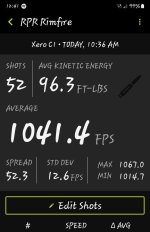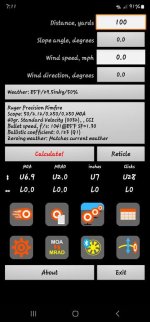cmj8591
Member
I am going to preface this post by saying that I have owned a chronograph in the past. It was a Chrony and gave good service for quite a while. When it gave up the ghost, I didn't run out and buy a new one right away but depended on the kindness of my shooting buddies to let me use theirs. Because of this, I was able to get some range time with a couple of different brands. Namely, an older Oehler and a Caldwell. They worked fine and did what they were supposed to do but it is a pain to deal with sky screens or units that have to be placed in front of your firing position. Mostly I used them when I was working up new loads or going off script with old ones and because of the amount of hassle, I tried not to use them too often. Then a buddy bought a LabRadar. It was a game changer. It is easy to set up and sits on the bench next to your gun. It was also nice to not have to play around trying to get the screens to line up with your target. It has a couple of drawbacks, mostly expense and it is a bit sensitive about how it is set up when it's trying to clock your shots but it was a world more convenient than the others. I decided to stop being a dead beat to my friends and buy my own unit. This was at the beginning of COVID and we all know what that did to the electronics supply chain. Needless to say, I never was able to find one that wasn't twice the MSRP so I waited. It worked out. Garmin came out with the Xero C1 Pro. Reading the on line reviews, it caught my attention and around Christmas time, I decided to buy one as soon as it came available. What I ended up doing is back ordering from MidwayUSA. One showed up a couple of days ago and in the chronograph world, it is a HUGE game changer. Start with the size. It is about the size of a small bar of soap and probably weighs less. That's it. The LabRadar is huge by comparison. Like the LabRadar, it uses Doppler radar to measure the bullet speed. With it's included tripod, the Garmin fits into one of the small pockets on my range bag. It is something that I can have at every range session and takes up little space. The unit comes the small tripod and a USB cable. It is crazy simple to use. You place it on the bench about 15 inches back from the muzzle and about 15 inches to the side. It has a diagram that it will display to show you where it wants to be placed but I think there is a lot of leeway. The setup menu is very simple and I didn't have to change anything from how it came out of the box. The usage menu is just as simple. Once you turn the unit on, it asks if you want to start a new session. It then asks a couple of questions about what you are shooting, handgun or rifle, and your velocity range. There is the ability to enter the weight of the bullet and if you elect to do that, it will calculate the energy and the power factor. Then you start shooting. It is truly that simple. The unit will save up to 50 sessions with 100 shots. There is an app (Of course there's an app!) that you can use on your smart phone or tablet. I installed it on my iPad mostly because I have enough stuff going on with my phone. The chrno syncs with the iPad via Bluetooth. Once I got mine out of the box, I went to the Garmin website to update it. That is also an easy process. You establish an account and then plug in your chronograph. It will then update with the latest software. It took about 5 minuets for mine. I made a little plan to break it in and teach myself about the operation. I took a Marlin 1894 44 magnum carbine, a S&W, 629 with 6 ½ inch barrel, a 629 with a 3 inch barrel and 30 rounds of a handload that consisted of 24.8 grains of H110 and a 240 grain Magnus JSP. My goal was to chronograph the same load out of the three different barrel lengths in three different "sessions". No earth shattering ballistic new ground to cover here but it would give me enough data to figure out how to manipulate it. It is a beautiful winter day here in the Bay State but a bit cold at 17 degrees. I set up at the bench and started in. Did I mention how easy this unit is to use? Turn it on, tell it what you are doing and set it on the bench. That's it. I fired 10 rounds with each gun in three sessions, one for each gun. It registered every shot without any kind of burp whatsoever.
Here are the average results:
1894 Marlin: 1739fps average. SD 25.2
S&W 629 6.5" barrel: 1215fps SD 27.6
S&W 629 3" barrel: 1066fps SD 42.5
I started with 100% charge and after an hour of being on in 17 degrees, the power bar had not moved. The display can be customized to show three data fields in addition to the velocity of the shot just fired. Mine is set up to show high, average and low but you also have the ability to use SD, power factor, deviation from average and extreme spread. It keeps track of all of these things and the app will display them after you sync the unit to your mobile device. So who is this chronograph for? If you're an occasional shooter and don't do performance based reloading, it's probably a waste of money. If you depend on factory loads for hunting, it won't be of much use. If you reload strictly for volume shooting, I don't think it will add much to what you are doing. If you are asking yourself "What do I do with this?" then you probably don't need it. This is a tool for shooters who reload and want to know what their loading process is producing, be it rifle or pistol. It is really not necessary for someone who loads or shoots casually. You can get everything you need from a good reloading manual. If you have a LabRadar and it's working well, I wouldn't go selling it off at a loss to get into one of these. But if you've been thinking about upgrading an old unit or dumping your sky screens, this is the way to go and I think is well worth the investment.
Pros:
Did I mention how easy it is to use? Set up is simple and the instructions are intuitive.
Very convenient. Easy to keep in your range bag for those times when you need it but didn't think you would.
It's a Garmin. They make great stuff and have very good support. I've used and abused a few of their GPS' and the Xero seems to be of the same solid construction.
Cons:
The price. I paid $599 from MidwayUSA. Maybe they will drop in price down the road but we all know how that works. I'm still waiting for $50 primers.
The app is a bit lame. It's easy to navigate but it doesn't give much beyond the raw data. If you need more, you will have to find a good ballistics program. (There's lots of free ones out there. I like the Hornady program.)
Outside of updates, there is little or no PC compatibility. The app is built around mobile devices. There is an option to save sessions as CSV files so that you can build a spread sheet but I had to e mail the data to myself so that I could use Excell on my Windows laptop.

Here are the average results:
1894 Marlin: 1739fps average. SD 25.2
S&W 629 6.5" barrel: 1215fps SD 27.6
S&W 629 3" barrel: 1066fps SD 42.5
I started with 100% charge and after an hour of being on in 17 degrees, the power bar had not moved. The display can be customized to show three data fields in addition to the velocity of the shot just fired. Mine is set up to show high, average and low but you also have the ability to use SD, power factor, deviation from average and extreme spread. It keeps track of all of these things and the app will display them after you sync the unit to your mobile device. So who is this chronograph for? If you're an occasional shooter and don't do performance based reloading, it's probably a waste of money. If you depend on factory loads for hunting, it won't be of much use. If you reload strictly for volume shooting, I don't think it will add much to what you are doing. If you are asking yourself "What do I do with this?" then you probably don't need it. This is a tool for shooters who reload and want to know what their loading process is producing, be it rifle or pistol. It is really not necessary for someone who loads or shoots casually. You can get everything you need from a good reloading manual. If you have a LabRadar and it's working well, I wouldn't go selling it off at a loss to get into one of these. But if you've been thinking about upgrading an old unit or dumping your sky screens, this is the way to go and I think is well worth the investment.
Pros:
Did I mention how easy it is to use? Set up is simple and the instructions are intuitive.
Very convenient. Easy to keep in your range bag for those times when you need it but didn't think you would.
It's a Garmin. They make great stuff and have very good support. I've used and abused a few of their GPS' and the Xero seems to be of the same solid construction.
Cons:
The price. I paid $599 from MidwayUSA. Maybe they will drop in price down the road but we all know how that works. I'm still waiting for $50 primers.
The app is a bit lame. It's easy to navigate but it doesn't give much beyond the raw data. If you need more, you will have to find a good ballistics program. (There's lots of free ones out there. I like the Hornady program.)
Outside of updates, there is little or no PC compatibility. The app is built around mobile devices. There is an option to save sessions as CSV files so that you can build a spread sheet but I had to e mail the data to myself so that I could use Excell on my Windows laptop.









